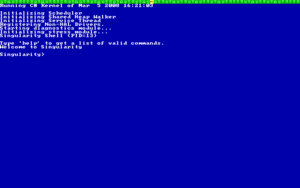Singularity
| Singularity project | |
|---|---|
 Singularity after startup |
|
| developer | Microsoft Corporation |
| License (s) | Microsoft Research License |
| Current version | 2.0 (November 14, 2008) |
| Kernel | Microkernel |
| Architecture (s) | x86 |
| Microsoft Research Singularity Project | |
Singularity was an experimental project by Microsoft Research with the aim of creating a reliable operating system in which the kernel , device drivers and all applications are written in managed code . The Singularity operating system pursues a new security concept called software-isolated processes (SIPs) . Since March 4, 2008, the source code is publicly available under the Microsoft Research License .
concept
The operating system is designed as a microkernel system. The kernel and device drivers are written in managed code , whereby Sing # , a variant of the C # derivative Spec # , is used.
The kernel consists of:
- Scheduler, page management and an I / O manager (microkernel),
- a channel manager that manages the communication between the individual SIPs,
- a class library.
All processes that do not take place at the kernel level are encapsulated in SIPs. These are closed code and object spaces, not address space units. All communication between such SIP units takes place via bidirectional channels; the data exchange is type-safe.
Applications
Applications are CLR programs.
Web links
- Singularity on Microsoft Research
- Singularity source code from Codeplex
- Singularity Design (PDF; 632 kB)
- Detailed overview of the Singularity project (English; PDF)
- http://sarwiki.informatik.hu-berlin.de/Singularity
Individual evidence
- ↑ James Larus, Galen Hunt: The Singularity System | August 2010 | Communications of the ACM. Retrieved December 10, 2018 .
- ↑ WinFuture: Microsoft releases non-Windows operating system , Michael Thistle Mountain, 5 March 2008 ; Retrieved December 8, 2016 .